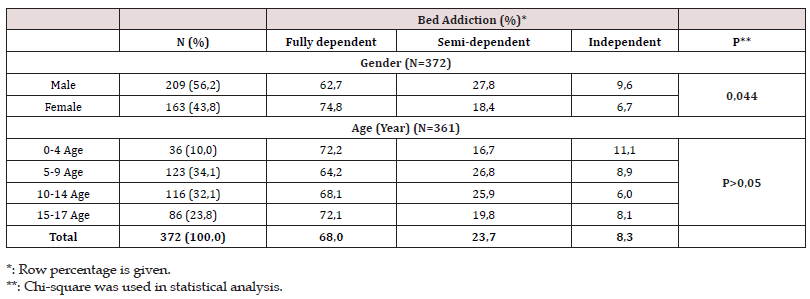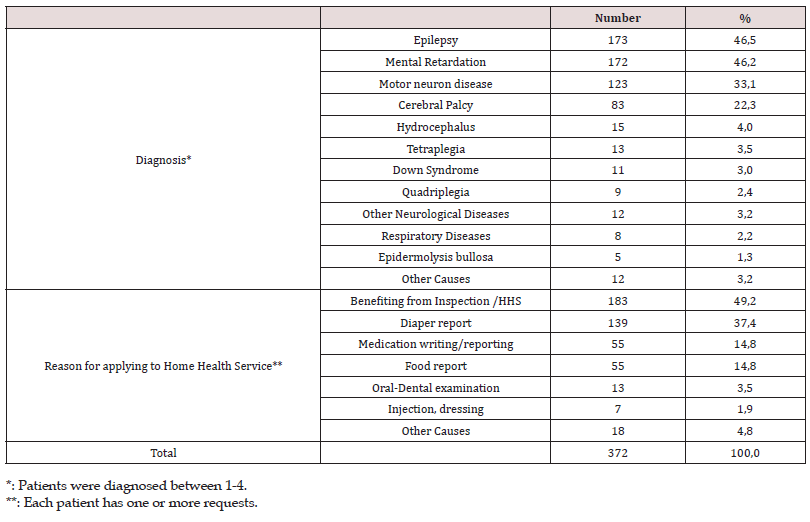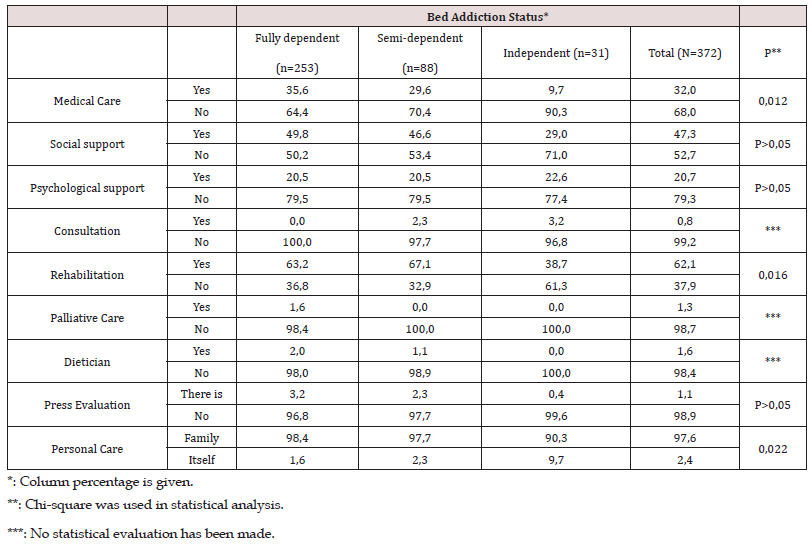
Lupine Publishers Group
Lupine Publishers
Menu
ISSN: 2638-6062
Research Article(ISSN: 2638-6062) 
Evaluation of Pediatric Patients Receiving Home Health Services Volume 5 - Issue 1
İzzettin Toktaş1* and Muzaffer Balibey2
- 1M.D., Department of Public Health, Faculty of Medicine, Mardin Artuklu University, Mardin, Turkey
- 2M.D., Department of Pediatrics, Diyarbakir Children’s Hospital, Diyarbakır, Turkey
Received: June 22, 2023; Published: July 05, 2023
*Corresponding author: İzzettin Toktaş, Public Health Specialist, Department of Public Health, Faculty of Medicine, Mardin Artuklu University, Mardin, Turkey
DOI: 10.32474/PRJFGS.2023.04.000203
Abstract
Background: Home health service is the provision of health and care and follow-up services to patients in line with the recommendations of physicians, in the environment they live with their families, by the healthcare team in a way that meets their medical needs, including rehabilitation, physiotherapy and psychological treatment. This study was conducted to evaluate the medical conditions of pediatric patients receiving home health services.
Methods: This descriptive study includes pediatric patients under the age of 18 who received home health services from Diyarbakır Pediatric Hospital in Turkey. The files of patients who applied to the home health unit between 2017 and 2020 and were actively followed up were reviewed retrospectively. The diagnoses, reasons for demand and medical needs of the patients were examined.
Results: The mean age of 372 patients who received home health services was 10.9±4.3 years. 46.5% of the patients were diagnosed with epilepsy, 46.2% with mental retardation, 22.3% with cerebral palsy. Home health services are mostly requested for examination (49.2%), diaper (37.4%), medicine (14.8%) and formula (14.8%) reports. While 74.8% of girls are fully bedridden, 62.7% of boys are fully dependent (p<0.05). Most of the patients who are bedridden are provided with personal care by their families. 35.6% of bedridden patients and 29.6% of semi-dependent patients need medical care (p<0.05). While 63-67% of bedridden patients need rehabilitation, 38% of not bedridden patients need rehabilitation (p<0.05).
Conclusions: Most of the patients receiving home health services are bedridden and have neurological diseases. As bed dependency increases, the need for medical care increases.
Keywords: Child; disabled; home care services; mental retardation; cerebral palsy
Introduction
The concept of “home visit” in Turkey was officially mentioned in the Public Health Law in 1931 for the first time [1]. However, the scope and definition of home care service was determined clearly by the legislation in 2005 for the first time [2]. Home health service is the provision of examination, analysis, treatment, medical care, follow-up, and rehabilitation services, including social and psychological counseling services, at home and in the family environment, to individuals who need home health services due to various diseases [3]. When it comes to home health services, the first patient group that comes to mind is bedridden patients [4]. The age groups to which home care services are directed are mainly elderly patients aged 65 and over who require chronic and long-term care, as well as all age groups with chronic diseases, infants, and children [5]. In recent years, developments in technology and medicine have led to an increase in the number of children with chronic diseases and technologydependent, while reducing mortality rates. This situation has led to the long-term use of intensive care and emergency room beds, which are specialized units, and an increase in health costs [6].
In addition to the financial problems, the inadequacy of the existing bed numbers in the hospitals and the problems related to the inability to provide the service in an efficient way have led to the search for alternative models to institutional care services [7]. Thus, home health services will not only prevent unnecessary health expenditures, but also reduce the burden of hospitals and ensure more efficient use of bed capacities [8]. Decrease in mortality rates, increased survival among premature babies, increase in the number of children in need of care, development of appropriate technical equipment for home use, changes in family structure, development of family-centered care approach and investigation of cost-effective methods in care services have affected the development of child home care constitute factors [9]. This study was conducted to evaluate the medical conditions of pediatric patients receiving home health services.
Materials and Methods
This descriptive study includes pediatric patients under the age of 18 who received home health services from Diyarbakır Pediatric Hospital. The ethics committee approval was obtained from Health Sciences University Gazi Yaşargil Training and Research Hospital for the study. (Ethics Committee No: 862/03.09.2021). The files of patients who applied to the home health unit between 2017 and 2020 and were actively followed up were reviewed retrospectively. Patients of age, gender, diagnosis of the disease, reason for requesting home health care, what kind of care the patient needs (medical care, social support, psychological support, rehabilitation need, palliative care need, dietitian), bed dependency status, pressure assessment and personal care data on how it was done were examined. Patients whose service was terminated were excluded. The numbers and percentages of the obtained data were calculated. Chi-square was used in statistical analysis. P<0.05 was considered statistically significant.
Results
Of the 372 patients who received home health services, 56.2% were male and 43.8% were female. The mean age is 10.9±4.3 years. 46.5% of the patients were diagnosed with epilepsy, 46.2% with motor mental retardation (MMR), 33.1% with motor neuron disease, 22.3% with cerebral palsy (CP). Home health services receive the highest number of requests for examination (49.2%), diaper (37.4%), medication (14.8%) and formula (14.8%) reports (Table 1). 68% of the patients are fully bedridden, 23.7% semidependent and 8.3% are not bedridden. While 74.8% of girls are fully bedridden, 62.7% of boys are fully dependent (p<0.05) (Table 2). Most of the bedridden patients are provided with personal care by their families. 35.6% of bedridden patients and 29.6% of semi-dependent patients need medical care (p<0.05). While 63-67% of bedridden patients need rehabilitation, 38% of not bedridden patients need rehabilitation (p<0.05) (Table 3).
Table 2: Evaluation of bed dependency of pediatric patients receiving home health services according to age and gender.

Discussion
According to TUIK data, the total population of Diyarbakır in 2020 is 1,783,431, 38.3% of which are children under the age of 18 [10]. It is aimed by the Ministry of Health to provide home health services to two per thousand of the total population [11]. Between the years 2011-2018 in Turkey, 6% of the patients receiving home health services are children under the age of 18 [12]. Our study includes 372 patients who received service from a home health service unit of a children’s hospital in Diyarbakır. Children who receive home health services only in this hospital constitute 10.4% of the total target population in Diyarbakır in 2020. This situation shows that there is an increase in pediatric patients receiving home health services due to the increase in the number of children with chronic diseases and that awareness in society is increased. In our study, the male/female ratio of the patients receiving home health services was 1.28, while the mean age was 10.9±4.3 years. In the study of Ayar et al. [13] the male/female ratio of patients receiving home health services in Ankara; 1.17, mean age 8.87, Çadırcı et al. “[9]” in their study in Şanlıurfa, the male/female ratio was 1.34, while the mean age was 11±4.2. Our study was found to be compatible with the literature in terms of age and gender
When we examine the patients receiving home health services according to their diagnoses; In the study of Ayar et al., it was determined that 58.7% of the patients were followed up with the diagnosis of CP and MMR, 11.1% of them were diagnosed with SSPE and 50.8% of these patients were diagnosed with epilepsy in addition to their primary disease[13]. Çadırcı et al., in the study performed by it was determined that 57.9% of the patients were followed with CP, 12.5% MMR, 11.8% with Neural Tube Defect (NTD) and 9.2% with SSPE [9]. In the study of Palfrey et al., 13.3% of the patients were diagnosed with neurological causes, 12% with MMR, 31.3% with congenital anomalies, 16% with perinatal conditions, 27% with organ-specific conditions and it was determined that it was followed up for symptoms [14]. In the study conducted by Döğer, it was determined that 33.6% of the patients were given home health services due to CP, 32.8% to resistant epilepsy and 16.1% to MMR [15]. In our study, 46.5% of the patients had epilepsy, 46.2% had MMR, 33.1% had motor neuron disease, 22.3% had CP.
It was determined that most of the patients received home health services for neurological reasons and with additional diagnoses ranging from 1-4. In our study, according to the literature, although neurological diseases were at the forefront, the rate of patients followed up with congenital anomalies such as NTD was very low. This may be due to the fact that the hospital is only a children’s hospital and there is no obstetrics clinic. The patients followed up with congenital anomalies may have been followed up by the home health services units of the hospitals with the obstetrics and gynecology clinics in the province together. The fact that the patients were diagnosed between 1-4 shows that the level of dependency on the service is high and the need for home health services. In the study of Ayar et al. according to the study done by; health personnel visited 84% of the patients for routine control (physical therapy, oral care, etc.), 3.2% for the supply of consumables, 3.1% for reporting, 2.9% for examinations [13]. In our study, it was determined that they applied to home health services most frequently due to examination (49.2%), diaper (37.4%), medication (14.8%) and formula (14.8%).
In our study, diaper, drug, and formula report demands were found to be higher. This is due to the fact that we calculate each incoming request separately. Home health service can consist of multiple demands. For example, inspection and report or multiple requests can be made at the same time. Willits et al., in their study, it was found that the frequency of home care visits was higher in children under the age of six, with female gender and functional limitations [16]. In our study, full bed dependence was found to be higher in girls (74.8%) than boys (62.7%). Medical care needs and physical therapy rehabilitation needs of pediatric patients receiving home health services; It was found to be higher in bedridden compared to non-bedridden people. We expect that the frequency of visits will be higher as the high rate of bedridden girls is higher and the medical need is higher in bedridden patients. In this respect, our study is compatible with literature. Çadırcı et al., in the study by; It was found that the personal care of the children receiving home health services was mostly done by their families (98%), mostly by the mother (92.8%)[9].
In the study of Ayar et al., it was determined that the person most interested in the primary care of the patients was 95.2% of the mother [13]. In our study, it was found that the personal care of the patients was done by family members of 90-98%. 1.6% to 2.3% of bedridden patients; It was determined that 9.7% of the patients who were not bedridden carried out personal care by the patient himself. In our study, similar to other studies, the personal care of the patients is mostly done by their families, especially by the mother. The home environment is a positive stimulus for a healthy or sick child that supports socially and emotionally. Social support is an important factor in determining the employment status of caregivers. Unemployed parents who are alone or without social support experience depression and burnout, and their quality of life is getting low [17]. With home health services, parents will not be left alone in the health problems they may experience with the patient, hospitalizations will be reduced by preventing the complications that may occur, and the country’s economy will be contributed.
Conclusion
Most home care patients are bedridden and have neurological diseases. Studies on the etiology of neurological diseases and the measures to be taken and the reduction of this patient group may also be the subject of separate studies and projects. As bed dependency increases, the need for medical care increases. The personal care of the patients receiving home care service is done by their families. With home health care, hospitalizations are reduced, and public costs are reduced. However, with a holistic approach, parents should be socially supported so that they are not adversely affected.
Acknowledgement
We would like to thank Health Officer Faruk GÜZEL for his contributions during the data collection phase. *This study was presented as an oral presentation at the “43rd Pediatrics Days and 22nd Pediatrics Nursing Days Congress” held online between 30 May - 2 June 2021.
Conflicts of Interest
The authors have no conflicts of interest to declare.
Funding
This research did not receive any specific grant from funding agencies in the public, commercial, or not-for-profit sectors.
Author Contribution
The authors confirm contribution to the paper as follows: study conception and design: İT, MB; data collection: MB; analysis and interpretation of results: İT, MB; draft manuscript preparation: İT; review & editing, supervision: İT, MB. All authors reviewed the results and approved the final version of the manuscript.
References
- Çoban M, Esatoğlu AE, İzgi MC (2014) Historical evolution of home care applications in legislative base in Turkey. Turk J Bioeth 1(3): 154-176.
- C. Presidential Official Gazette. Regulation on the Delivery of Home Care Services.
- C. Presidential Legislation Information System. Regulation on the provision of home health services by the Ministry of Health and its affiliates.
- Çayır Y (2013) Home health services in primary care: What can we do? Dicle Med J 40(2): 340-344.
- Özer Ö, Şantaş F (2012) Home Care Services Provided by The Public Sector and Its Finance. ACU Heal Sci J 3(2): 96-103.
- Harputluoğlu N, Çelik T, Karaarslan U, Uysal S (2021) The Importance of Collaboration of the Home Health Care Unit and Pediatric Palliative Care Unit in Children. J Pediatr Emerg Intensive Care Med 8: 83-87.
- Tekin Ç (2018) Developments in the Field of Home Patient Care Services. FU Med J Heal Sci 32(2): 115 -117.
- Çelik-Güzel E, Toprak D (2018) Home Health Services in Turkey. J clin Med Fam Med 10(5): 15-19.
- Çadırcı D, Kepenek E, Örenler M, Yavuz-Dağlıoğlu EB, Güzelçiçek A (2019) Evaluation of Home Care Services Provided for Childhood Patients. Konuralp Med J 11(3): 377-383.
- Turkish Statistical Institute (TUIK). Population by province, single age, and sex 2007-2020.
- Aslan Ş, Uyar S. ve Güzel Ş (2018) Home Health Care Services Practice in Turkey. J Soc Res Manag (1): 45-56.
- C. Ministry of Health, General Directorate of Public Hospitals. Home Health Services. HIMSS 18 Eurasia Health informatics Fair and EMRAR Education Conference, 25-27 October 2018; Istanbul, Turkey.
- Ayar G, Şahin Ş, Uysal-Yazıcı M, Gündüz RC, Yakut Hİ, et al. (2015) Evaluation of Home Care Services in Chronically ill Children. Turk J Pediatr Dis 1: 12-17.
- Palfrey JS, Sofis LA, Davidson EJ, Liu J, Freeman L, et al. (2004) Pediatric Alliance for Coordinated Care. The Pediatric Alliance for Coordinated Care: evaluation of a medical home model. Pediatrics 113(5 Suppl): 1507-1516.
- Döğer C (2018) Evaluation of home health care in pediatric cases. Notice booklet. 5th International Home Health and Social Services Congress, 26-28 April 2018, Antalya, Turkey. EVSAD pp. 11-15.
- Willits KA, Platonova EA, Nies MA, Racine EF, Troutman ML, et al. (2013) Medical home and pediatric primary care utilization among children with special health care needs. J Pediatr Health Care 27(3): 202-208.
- Didişen NA, Çevik-Özdemir HN, Keskin E (2017) Technology Depends on Children and Home Care. J Pediatr Emerg Intensive Care Med 4: 123-129.

Top Editors
-

Mark E Smith
Bio chemistry
University of Texas Medical Branch, USA -

Lawrence A Presley
Department of Criminal Justice
Liberty University, USA -

Thomas W Miller
Department of Psychiatry
University of Kentucky, USA -

Gjumrakch Aliev
Department of Medicine
Gally International Biomedical Research & Consulting LLC, USA -

Christopher Bryant
Department of Urbanisation and Agricultural
Montreal university, USA -

Robert William Frare
Oral & Maxillofacial Pathology
New York University, USA -

Rudolph Modesto Navari
Gastroenterology and Hepatology
University of Alabama, UK -

Andrew Hague
Department of Medicine
Universities of Bradford, UK -

George Gregory Buttigieg
Maltese College of Obstetrics and Gynaecology, Europe -

Chen-Hsiung Yeh
Oncology
Circulogene Theranostics, England -
.png)
Emilio Bucio-Carrillo
Radiation Chemistry
National University of Mexico, USA -
.jpg)
Casey J Grenier
Analytical Chemistry
Wentworth Institute of Technology, USA -
Hany Atalah
Minimally Invasive Surgery
Mercer University school of Medicine, USA -

Abu-Hussein Muhamad
Pediatric Dentistry
University of Athens , Greece

The annual scholar awards from Lupine Publishers honor a selected number Read More...






